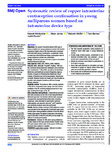Systematic review of copper intrauterine contraception continuation in young nulliparous women based on intrauterine device type
| dc.contributor.author | Akintomide, H | |
| dc.contributor.author | James, Alison | |
| dc.contributor.author | Moffat, M | |
| dc.contributor.author | Barnes, P | |
| dc.contributor.author | Rankin, J | |
| dc.date.accessioned | 2022-10-24T14:21:45Z | |
| dc.date.available | 2022-10-24T14:21:45Z | |
| dc.date.issued | 2022-10 | |
| dc.identifier.issn | 2044-6055 | |
| dc.identifier.issn | 2044-6055 | |
| dc.identifier.other | e060606 | |
| dc.identifier.uri | http://hdl.handle.net/10026.1/19746 | |
| dc.description.abstract |
<jats:sec><jats:title>Objectives</jats:title><jats:p>No copper intrauterine device (IUD) type is known to better suit young nulliparous women who tend to experience higher rates of IUD discontinuation compared with their older parous counterparts. A systematic review to determine which IUDs have higher continuation rates in young nulliparous women was undertaken.</jats:p></jats:sec><jats:sec><jats:title>Design</jats:title><jats:p>Systematic review and meta-analyses of available evidence based on IUD type.</jats:p></jats:sec><jats:sec><jats:title>Data sources</jats:title><jats:p>AMED, BNI, CINAHL, DARE, EMBASE, EMCARE, HMIC, MEDLINE, PsycINFO, PubMed, TRIP, and the Cochrane Library electronic databases were searched from inception to 11 May 2022; as well as the Bandolier, Medicines and Healthcare products Regulatory Agency, Faculty of Sexual and Reproductive Healthcare, Royal College of Obstetricians and Gynaecologists, Department of Health, National Institute for Health and Care Excellence, Scottish Intercollegiate Guidelines, WHO and Google Scholar websites.</jats:p></jats:sec><jats:sec><jats:title>Eligibility criteria</jats:title><jats:p>All studies on IUDs currently available in the UK or comparable (same design and size) to those available in the UK, involving nulliparous women of any age including those aged under 30.</jats:p></jats:sec><jats:sec><jats:title>Data extraction and synthesis</jats:title><jats:p>Independently extracted data were assessed as low risk of bias using the Mixed Methods Appraisal Tool. Random effects meta-analyses of proportions were performed where data, including subgroups, were amenable to quantitative synthesis. Heterogeneity was reported using tau<jats:sup>2</jats:sup> and I<jats:sup>2</jats:sup> statistics, and sensitivity analyses were also performed.</jats:p></jats:sec><jats:sec><jats:title>Results</jats:title><jats:p>Nineteen studies involving 13 045 nulliparous women were included but the heterogeneity of participant ages, parity and IUD types made quantitative synthesis of outcome data in totality inappropriate. The highest continuation rate obtained was 91.02% (95% CI 88.01% to 93.64%) for the smaller TCu 380A at 12 months post insertion.</jats:p></jats:sec><jats:sec><jats:title>Conclusions</jats:title><jats:p>Evidence for IUD use in young nulliparous women based on IUD type remains limited. Smaller sized IUD types appear better suited to this group of IUD users, however, more research is needed.</jats:p></jats:sec><jats:sec><jats:title>PROSPERO registration number</jats:title><jats:p>CRD42019120969.</jats:p></jats:sec> | |
| dc.format.extent | e060606-e060606 | |
| dc.format.medium | Electronic | |
| dc.language | en | |
| dc.language.iso | eng | |
| dc.publisher | BMJ Publishing Group | |
| dc.subject | reproductive medicine | |
| dc.subject | community gynaecology | |
| dc.subject | public health | |
| dc.title | Systematic review of copper intrauterine contraception continuation in young nulliparous women based on intrauterine device type | |
| dc.type | journal-article | |
| dc.type | Journal Article | |
| dc.type | Systematic Review | |
| dc.type | Research Support, Non-U.S. Gov't | |
| plymouth.author-url | https://www.webofscience.com/api/gateway?GWVersion=2&SrcApp=PARTNER_APP&SrcAuth=LinksAMR&KeyUT=WOS:000866249200001&DestLinkType=FullRecord&DestApp=ALL_WOS&UsrCustomerID=11bb513d99f797142bcfeffcc58ea008 | |
| plymouth.issue | 10 | |
| plymouth.volume | 12 | |
| plymouth.publication-status | Published | |
| plymouth.journal | BMJ Open | |
| dc.identifier.doi | 10.1136/bmjopen-2021-060606 | |
| plymouth.organisational-group | /Plymouth | |
| plymouth.organisational-group | /Plymouth/Faculty of Health | |
| plymouth.organisational-group | /Plymouth/Faculty of Health/School of Nursing and Midwifery | |
| plymouth.organisational-group | /Plymouth/Users by role | |
| plymouth.organisational-group | /Plymouth/Users by role/Academics | |
| dc.publisher.place | England | |
| dcterms.dateAccepted | 2022-08-09 | |
| dc.rights.embargodate | 2022-10-25 | |
| dc.identifier.eissn | 2044-6055 | |
| dc.rights.embargoperiod | Not known | |
| rioxxterms.versionofrecord | 10.1136/bmjopen-2021-060606 | |
| rioxxterms.licenseref.uri | http://www.rioxx.net/licenses/all-rights-reserved | |
| rioxxterms.type | Journal Article/Review |


